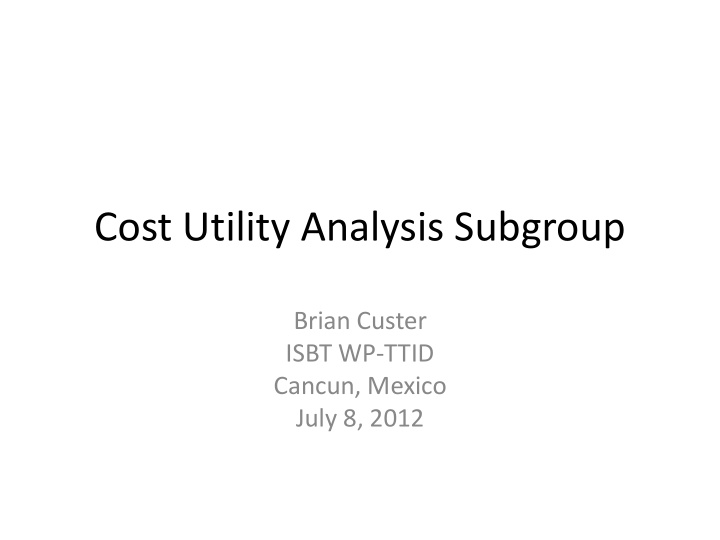



Cost Utility Analysis Subgroup Brian Custer ISBT WP-TTID Cancun, Mexico July 8, 2012
Global risk assessment and cost utility of blood safety interventions – development of a web- based application and multi-country analysis framework
Subgroup meeting July 7, 2012 Mart Janssen, Ginette Michaud, Andrew Heaton, Jose Levi, Henk Resnik, Brian Custer Reviewed the website Discussed the remaining tasks and problems Reviewed available use statistics Discussed new ideas
Web-Interface http://bloodsafety.isbtweb.org/cua Development of the web-interface was sponsored by the ISBT TTID working party. Goal: make Cost-Utility analyses of blood screening interventions available to a wide audience without requiring expertise on model development and/or health economics. Blood screening strategies consist of: 1) antibody assays (Abs) for HIV and HCV + HBV surface antigen (HBsAg), 2) antibody assays that include antigens for the agents of interest (Combo tests), 3) NAT in minipools of 6 donations (MP NAT), and 4) individual donation (ID) NAT can be compared
Web interface http://bloodsafety.isbtweb.org/cua Country-specific data on the prevalence (and incidence where available) of each infection, percentage of first time and regular donors, cost of different testing methods, average age of transfusion recipients, transfusion survival and related parameters were used Results provided from the web-interface include the number infections interdicted using different ID screens, and as incremental cost per disability adjusted life year averted ($/DALY) The suggested UN/WHO threshold of three times the gross national income (GNI) per capita can be used to define which testing strategies can be classified as cost-effective Tool currently also accessible at: https://interactive.basecase.com/anon.py?isbt-cua
Introduction page
Steps 1. Risk model and donor population 2. Recipient/patient epidemiology 3. Infectious window periods 4. Donor screening costs 5. Methodology (health economic factors) 6. HIV+ disease progression and treatment costs 7. HBV+ and HCV+ disease progression 8. HBV and HCV treatment costs Results
Results options 1. Infections remaining, costs and DALYs 2. Incremental cost effectiveness ratios (ICERs) 3. Cost-effectiveness plane Download report
Results Infections, Costs and DALYs
Results for six countries Individual UN/WHO Abs+ Combo+ Minipool Country Donation Threshold HBsAg* HBsAg* NAT* NAT* (3xNGI) Brazil Dominant Dominant 299,300 1,254,000 22,050 Ghana Dominant 608 1,762 4,896 2,010 Not South Africa Dominant Dominant 174,700 17,334 Applicable Thailand Dominant 5,291 15,840 52,191 8,520 The Dominant 4,833,442 6,600,446 93,453,997 150,450 Netherlands Not USA 17,100 Applicable 2,934,000 24,729,000 144,669 *Anti-HIV, Anti-HCV, and HBsAg are compared to no intervention and then each intervention set is compared incrementally to the intervention set to the left. Combo means combined antibody and antigen assays. Not applicable means the testing strategy is not available in the country.
Website use in the last year • No formal registrations for the tool - all the logins to the tool were anonymous • Users only have to register if they want to save their data (create a new scenario that gets saved to the server) – People could have downloaded the report, but we cannot track this – Of the total 92 accesses, all ran one or more simulations, by entering new data or adjusting values in 6 countries.
Current issues Web site unavailable for a few months due to a web address change at ISBT http://bloodsafety.isbt-web.org/cua http://bloodsafety.isbtweb.org/cua Tracing model and web interface problem We are still struggling with a bug that was reported by Bio-Rad – Aberrant results when using the tool – Is this a result of the underlying model or a web interface
Completion of manuscript Focus on 6 countries Attempts to include other countries were not successful Face validity to be established by comparing results to published studies for the Netherlands and the USA Primary route for increasing knowledge and use of the tool
Updates on project Primary problem is outreach to facilitate use of the tool Need to work with TTID members to facilitate wider use Need to find ways to present/promote to wider audiences Submission of manuscript will be key to the enhancing knowledge of the project
New ideas How complex does a CUA analysis have to be? Is the current tool too complex Simplified model C an the core parameters necessary for an ‘order of magnitude’ assessment of cost -utility be developed?
New ideas International Forum Topic: Use of health economics and cost-utility studies in blood safety decision making • Different stakeholders will have different positions • Goal: Understand the breadth of opinions
Acknowledgements • ISBT TTID working party • CUA workgroup (Brian Custer, Mart Janssen, Gijs Hubben, Rene van Hulst) • A large group of people who provided the data for the 6 countries included in the tool (USA, Netherlands, Brazil, Ghana, Thailand, South Africa)
Questions and comments?
Steps in the Analysis
Results Incremental Cost Effectiveness Ratios
Results Cost Effectiveness Plane
USA data on previous analyses
Conclusions • The web-interface provides an easy to use tool for conducting cost-effectiveness analyses in blood screening. • Countries where the largest numbers of infections are interdicted through testing tend to have the most favorable cost-utility results. • As expected, the cost of testing and incremental health effects have a dramatic influence on cost-utility results. The value of the addition of NAT to serological testing is highly dependent on the country-specific prevalence and incidence of viral infections in blood donors. • The cost-utility of blood safety interventions in some countries does not meet the threshold developed by UN/WHO.
Recommend
More recommend